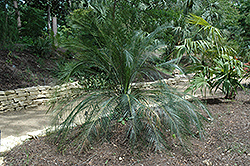Fri & Sat 8am - 8pm
Sun 8am - 7pm
Anytown, USA 12345
fax: 261.787.0463
e-mail: info@successgc.com


Plant Finder

Height: 4 feet
Spread: 4 feet
Sunlight:
![]()
![]()
Hardiness Zone: 7a
Description:
A medium to large cycad with a woody trunk that is typically underground, unless on a shallow, rocky site; long, arching pinnate leaves are graceful in form and texture; may produce female cones with red to orange seeds; watch for mealybugs and scale
Ornamental Features
Burrawang is primarily valued in the landscape or garden for its ornamental globe-shaped form. It has attractive green evergreen foliage. The narrow pinnately compound leaves are highly ornamental and remain green throughout the winter.
Landscape Attributes
Burrawang is a multi-stemmed evergreen shrub with a more or less rounded form. It lends an extremely fine and delicate texture to the landscape composition which can make it a great accent feature on this basis alone.
This shrub will require occasional maintenance and upkeep, and should not require much pruning, except when necessary, such as to remove dieback. It is a good choice for attracting bees and butterflies to your yard, but is not particularly attractive to deer who tend to leave it alone in favor of tastier treats. Gardeners should be aware of the following characteristic(s) that may warrant special consideration;
- Insects
Burrawang is recommended for the following landscape applications;
- Accent
- Rock/Alpine Gardens
- General Garden Use
Planting & Growing
Burrawang will grow to be about 4 feet tall at maturity, with a spread of 4 feet. It has a low canopy. It grows at a slow rate, and under ideal conditions can be expected to live to a ripe old age of 120 years or more; think of this as a heritage shrub for future generations!
This shrub does best in full sun to partial shade. It is very adaptable to both dry and moist growing conditions, but will not tolerate any standing water. It is not particular as to soil pH, but grows best in sandy soils. It is somewhat tolerant of urban pollution. This species is not originally from North America.


